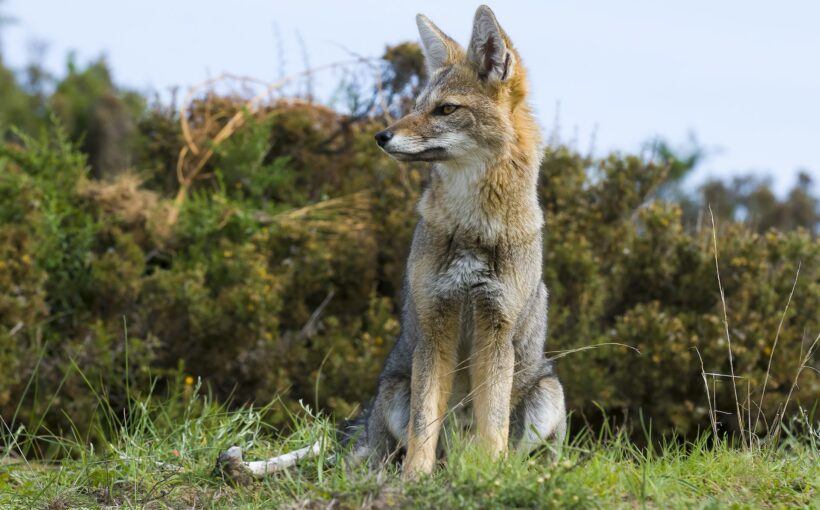
Next time you see a fox when out walking with your dog, pause for a moment and ponder their relatedness. Dogs and foxes are distinct but distantly related canine species.
Until recently, scientists thought it was impossible for them to breed. However, the discovery of a dog-fox hybrid in Brazil suggests that The Fox and the Hound might sometimes be a little more Lady and the Tramp.
The recent identification of the dog-fox hybrid known as a “dogxim” (a cross between dog and graxaim-do-campo, the Portuguese name for pampas fox) in Brazil also raises concerns about the impact that our pet dogs might have on wild animal populations and their survival.
This female, dog-like creature was first noticed when she was she was hit by a car and taken to a wildlife rehabilitation facility. The staff at the wildlife centre noticed she had a strange mix of physical and behavioural characteristics.
Her pricked ears and preference for eating small mammals seemed fox-like, but her barking was more reminiscent of a dog. Throughout the centuries there have been unverified reports of fox-dog hybrids, but none have been confirmed before with genetic testing.
Genetic testing revealed that she was a hybrid between a female pampas fox (Lycalopex gymnocercus) and a male domestic dog (Canis lupus familiaris). This is the first documented case of a dog-fox hybrid. Genetic analysis revealed she had a total of 76 chromosomes, compared to the 78 chromosomes of the domestic dog and 74 of the pampas fox.
What is a hybrid?
Hybridisation is when two species mate and produce offspring with mixed genetic ancestry. Normally, animals only mate with members of their own species.
Differences in the number of chromosomes (the structure in which DNA is packaged within the cell nucleus) often make species genetically incompatible with each other. Mating behaviour and courtship rituals tend to be individual to a species, such as the vocalisations of rutting deer, as is reproductive anatomy and physiology.
Many well-known hybrids, such as mules (horse and donkey), ligers (male lion and female tiger) and tigons (male tiger and female lion), are a result of human intervention. A lion and tiger would never meet naturally in the wild, as their native ranges are too far apart.
The more closely related (and thus genetically alike) two species are, the higher the chance of successful hybridisation. For example, dogs (Canis lupus familiaris) and grey wolves (Canis lupus) only diverged between 11,000 and 35,000 years ago. Wolf-dog hybrids are relatively common because their genetics, reproductive anatomy and behaviour are still fairly similar.
Most hybrids are sterile, meaning they are biological dead-ends. Even if differences in chromosome numbers and behaviour don’t prevent two species from producing young, it may make the hybrid infertile.
How common are hybrids?
Hybrids are more widespread than you might think – they are all around us in the plant world, both natural and as a result of human intervention.
Research suggests that approximately 25% of plant and 10% of animal species have been affected by interbreeding in the wild.
Many domesticated species can breed with their wild relatives too. In Poland, a 2018 study found high numbers of free-living wild boars had domestic genes, for example.
Hybrid offspring are not always infertile, and some people are concerned about how this affects the long-term survival and purity of individual species. Hybrids can outcompete and eventually even replace their parent species. For endangered species with small, fragile populations, this is a serious threat. In the case of the dogxim, her fertility was not verified. Sadly, reports suggest she has since died, so we will probably never know.
Why are hybrids controversial?
Hybridisation is important in the evolution of species, allowing populations to adapt to changing environments. Early humans are widely recognised in science to have mated with Neanderthals, helping our ancestors survive in some harsh environments. Long term, hybrids can lead to the development of entirely new species.
But there are also negative consequences. Physical abnormalities are common in hybrids including changes to skull, dental and horn structures, as seen in hybrid wildebeest.
Hybridisation is also a problem for vulnerable populations or endangered species, leading to reduced fitness and therefore the survival of individuals and even whole populations. The Scottish wildcat wild population, for instance, is now almost entirely made up of wildcat-domestic cat hybrids.
What does the dog-fox hybrid tell us?
The dog-pampas fox hybrid strongly suggests that contact between wild and domestic species is increasing, possibly because of human settlements encroaching on wild habitats. This can also significantly increase disease transmission risks.
The dogxim might well be a warning of the destructive impact humans and domesticated animals are having on biodiversity. We don’t know how many other hybrids may be living in the wild. Although the pampas fox is not considered endangered, this example of hybridisation between a domestic and wild species signals the importance of monitoring interactions between different species, to protect vulnerable or numerically low populations.
It is important to note that the pampas fox species is very different to the red fox (Vulpes vulpes). We probably do not need to worry about creating dog-fox hybrids on our daily dog walks, because of the genetic distance between the two. However, the dogxim should warn us that our dogs’ interactions with nature can have unexpected consequences.
![]()
Jacqueline Boyd is affiliated with The Kennel Club (UK) through membership, as Chair of the Activities Health and Welfare Subgroup and member of the Dog Health Group. Jacqueline also writes, consults and coaches on canine matters on an independent basis in addition to her academic affiliation.



